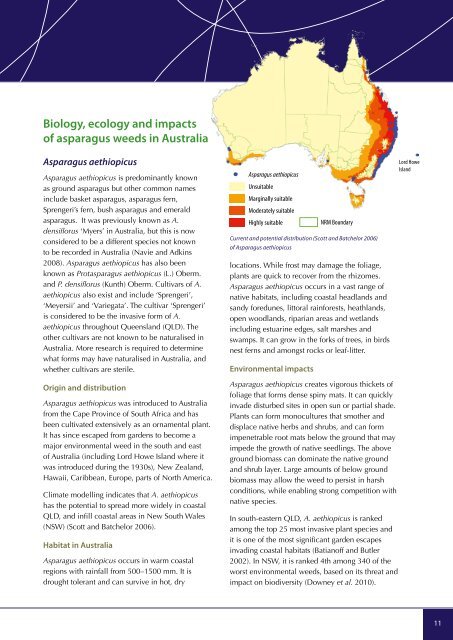Asparagus weeds - Weeds Australia
Asparagus weeds - Weeds Australia
Asparagus weeds - Weeds Australia
- No tags were found...
You also want an ePaper? Increase the reach of your titles
YUMPU automatically turns print PDFs into web optimized ePapers that Google loves.
Biology, ecology and impactsof asparagus <strong>weeds</strong> in <strong>Australia</strong><strong>Asparagus</strong> aethiopicus<strong>Asparagus</strong> aethiopicus is predominantly knownas ground asparagus but other common namesinclude basket asparagus, asparagus fern,Sprengeri’s fern, bush asparagus and emeraldasparagus. It was previously known as A.densiflorus ‘Myers’ in <strong>Australia</strong>, but this is nowconsidered to be a different species not knownto be recorded in <strong>Australia</strong> (Navie and Adkins2008). <strong>Asparagus</strong> aethiopicus has also beenknown as Protasparagus aethiopicus (L.) Oberm.and P. densiflorus (Kunth) Oberm. Cultivars of A.aethiopicus also exist and include ‘Sprengeri’,‘Meyersii’ and ‘Variegata’. The cultivar ‘Sprengeri’is considered to be the invasive form of A.aethiopicus throughout Queensland (QLD). Theother cultivars are not known to be naturalised in<strong>Australia</strong>. More research is required to determinewhat forms may have naturalised in <strong>Australia</strong>, andwhether cultivars are sterile.! <strong>Asparagus</strong> aethiopicus! <strong>Asparagus</strong> aethiopicusUnsuitableMarginally suitableModerately suitableUnsuitableMarginally suitableModerately suitableHighly suitableHighly suitableNRM BoundaryNRM BoundaryCurrent and potential distribution (Scott and Batchelor 2006)of <strong>Asparagus</strong> aethiopicuslocations. While frost may damage the foliage,plants are quick to recover from the rhizomes.<strong>Asparagus</strong> aethiopicus occurs in a vast range ofnative habitats, including coastal headlands andsandy foredunes, littoral rainforests, heathlands,open woodlands, riparian areas and wetlandsincluding estuarine edges, salt marshes andswamps. It can grow in the forks of trees, in birdsnest ferns and amongst rocks or leaf-litter.Environmental impactsLord HoweIslandOrigin and distribution<strong>Asparagus</strong> aethiopicus was introduced to <strong>Australia</strong>from the Cape Province of South Africa and hasbeen cultivated extensively as an ornamental plant.It has since escaped from gardens to become amajor environmental weed in the south and eastof <strong>Australia</strong> (including Lord Howe Island where itwas introduced during the 1930s), New Zealand,Hawaii, Caribbean, Europe, parts of North America.Climate modelling indicates that A. aethiopicushas the potential to spread more widely in coastalQLD, and infill coastal areas in New South Wales(NSW) (Scott and Batchelor 2006).Habitat in <strong>Australia</strong><strong>Asparagus</strong> aethiopicus occurs in warm coastalregions with rainfall from 500–1500 mm. It isdrought tolerant and can survive in hot, dry<strong>Asparagus</strong> aethiopicus creates vigorous thickets offoliage that forms dense spiny mats. It can quicklyinvade disturbed sites in open sun or partial shade.Plants can form monocultures that smother anddisplace native herbs and shrubs, and can formimpenetrable root mats below the ground that mayimpede the growth of native seedlings. The aboveground biomass can dominate the native groundand shrub layer. Large amounts of below groundbiomass may allow the weed to persist in harshconditions, while enabling strong competition withnative species.In south-eastern QLD, A. aethiopicus is rankedamong the top 25 most invasive plant species andit is one of the most significant garden escapesinvading coastal habitats (Batianoff and Butler2002). In NSW, it is ranked 4th among 340 of theworst environmental <strong>weeds</strong>, based on its threat andimpact on biodiversity (Downey et al. 2010).11
















